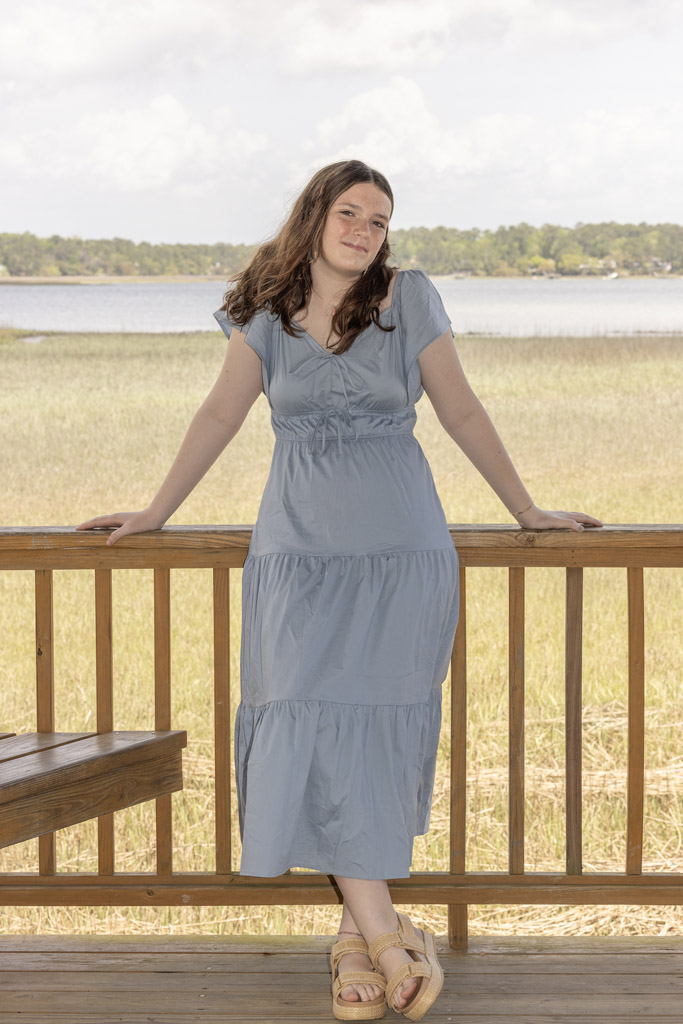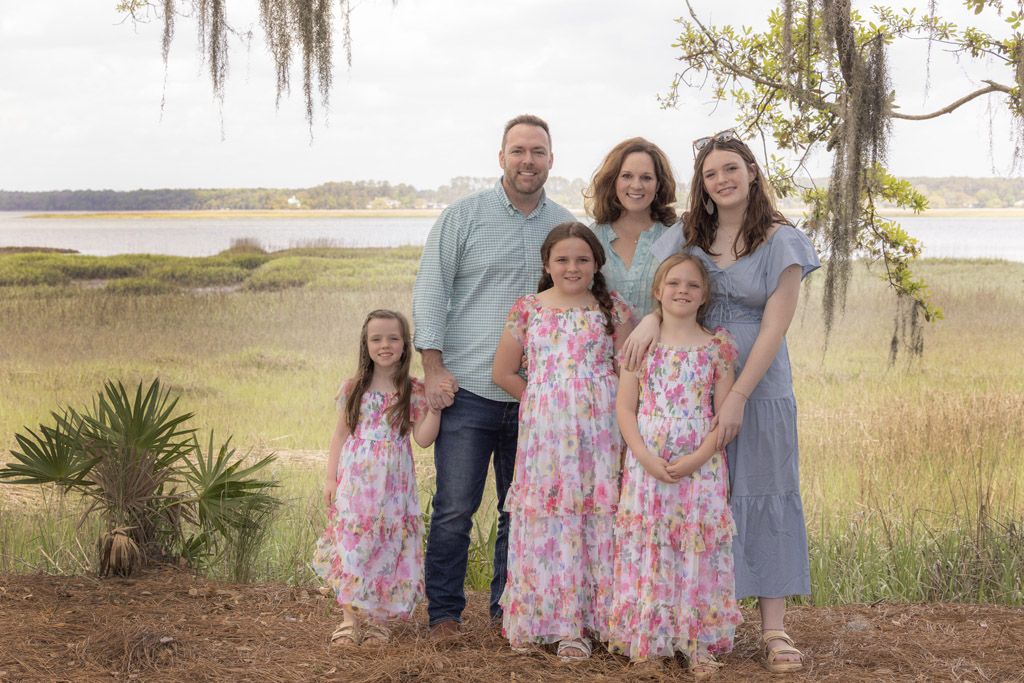Sofie Beth Jackson was sound asleep at home in Bluffton when her family’s first foster child arrived around midnight.
The 12-year-old had insisted that her parents, Holly and Brian, should wake her if ever she was in bed when a child arrived in their care. This night, they did just that.
“Sofie Beth got right up and got into her mothering mode,” her mother said. “We gave the child a bath, got her dressed, and Sofie Beth wanted to read her a book before bed.”
That was in 2024, after the Jackson adults were certified by the state of South Carolina to be a resource family, commonly known as a foster family. Locally, the program is administered by the Child Abuse Prevention Association (CAPA), a nonprofit organization that is licensed by the state to serve families in Beaufort, Jasper, Colleton, Hampton, and Allendale counties.
From the time her parents began including Sofie Beth and her three younger sisters in their conversations about becoming a foster family, she thought it would be cool. “At that point, I didn’t really understand the depth of it, but I was like, ‘Wow, to have another kid in our house, I would be really good at helping with that,’” she said.
“Sofie Beth has always been a leader,” Holly said. “We kind of joke that ‘She’s not bossy; she has strong leadership qualities.’ She’s very mother-like to her younger sisters, so it didn’t surprise me that she wanted to do this.”

Sofie Beth Jackson, a student at Bluffton Middle School, is a “huge help” with foster children in the care of the Jackson family.
Her mom said Sofie Beth is interested in the details of a foster child’s well-being. “Each child is required to have a doctor check-up within 48 hours of coming into my care,” Holly said. “Sofie Beth wants to know how did the doctor visit go, can I go to the doctor visit, can I go to the dentist with them. She wants to be part of the hard part.”
One of those hard parts involved a child whose behavior caused a moment of high stress for Holly. “I know that (Sofie Beth) saw it on my face, and she said, ‘I’ve got this’ and she did. She just took the child by the hand and went for a walk.”
Whether or not her being closer to a foster child’s age is part of that calming connection, Sofie Beth has an additional theory. “You’re still the authority figure,” she said to her mother, “and sometimes in their lives, that authority figure has let them down.”

Brian and Holly Jackson are photographed with their daughters, from left, Ruby Lee, 5; Gloria, 9; Penny,7; and Sofie Beth, 12. The girls help their parents when foster children come to stay with their family for a while.
Becoming a resource family
Holly became aware of CAPA in 2017 while working as a television news reporter. “When I worked for WSAV, I covered the opening of the CAPA foster family program,” she said. “I remember thinking ‘Wow, this might be something I’d be interested in.’”
She and Brian discussed the idea, but “We both tried to bury it. We tried to make it not work, and it just kept coming back,” Holly said. “We had so many reasons why we shouldn’t commit – life is too busy, we already have a lot of kids, we’ve got too much going on, we both have full time jobs.
One of Holly’s primary concerns was that she would become too attached to children in their care and couldn’t bear the thought of them leaving.
“Like so many people, I shut it down with the whole idea of ‘Oh, I could never give them back,’ she said. “(I thought) I would have to adopt them all because I couldn’t give them back!”
At some point in recent years, there was a shift in her perspective. What if everybody had that mindset and decided not to foster because of their own fears?
“So, I changed it into, ‘This is very likely the absolute worst period that (these children) will ever go through in their whole lives, and we could be a bright spot for them,’” she said. “Let’s be part of their lives – maybe just a small blip in their lives, but let’s let it be a relaxed and joyful blip.”
Getting a nudge from Sofie Beth was the final push they needed. “We had already agreed to get certified,” Holly said. “But we weren’t sure if we wanted to start immediately.”
Hearing this, Sofie Beth said, “Oh my gosh, can you please just say we’re ready to start? How will we know unless we try?”
Megan Buss, resource family case manager at CAPA, is familiar with the hesitation Holly and Brian experienced at first.
“One big fear is that the family will get attached to a child and won’t want to give them back,” Buss said. “But there are so many positives!”
Not only does the foster family provide a safe, stable, and nurturing environment for a child, but they can also provide the child with new social experiences, Buss said. “For example, some children have never seen Santa Claus, or have never eaten at a restaurant, or never attended a baseball game,” Buss said. When a foster family can do things like this with a child, “it turns out to be quite a beautiful thing.”
Buss said the general requirements for becoming a foster family include: the home must pass fire inspection, a background check on all family members over the age of 13, fingerprinting for everyone over 18, medical checkups for everyone, and a home study.
“The home study is where we talk about family history, see family dynamics, and learn about their discipline techniques,” Buss said. “It’s just getting to know them, their interest in fostering, and having them answer a questionnaire.”
After those criteria are met, and a family situation is deemed suitable, there is training. Held over three days, the sessions cover all sorts of potential issues and solutions. For instance, many children are coming from a trauma situation, so families get training in how to deal with the resulting behaviors.
From application to approval takes about two or three months, Buss said.
Families are advised to be prepared for a child to spend up to a year with them, though shorter time frames are more common. The Jacksons have welcomed a total of four children, ages 2 to 9, for durations that varied from two days to six weeks.
The entire Jackson family has embraced the program and their responsibilities as a foster family wholeheartedly. Holly is the primary caregiver, and handles the large and small details, from making sure the child is safe, fed, and clothed, health checkups, and all the details in between.
With a demanding job as a bank executive in Savannah, Brian’s involvement is mostly evenings and weekends, especially for fun adventures. On the regular, 7-year-old Penny said, her dad “makes our lunches and takes us to school,” and he always says “yes” to ice cream.
All four of the Jackson girls pitch in with love, support, and play.
“I really like having the opportunity to do something as a family, to be with and help the other kids,” said Gloria, age 9. Her mom said, “Gloria was a huge help with the school age child. She carried her in on her hip the first day of kindergarten.”
Ruby Lee, age 5, had fun with one of the girls who was her age. “They played together all the time,” Holly said. Penny chimed in, “Yeah, she taught the girl how to pull up stepping stones and find worms and snails and stinger bugs.”
“You have to wait until after the rain,” Ruby Lee said.
Brian is proud of his daughters and their efforts. “It’s really cool to watch them being little mamas and pitching in and helping,” he said.
When asked the first thing they do when they learn the family will be receiving a foster child, Penny said she wants to know “How old are they?”
Gloria said, “I get ready, get calm, and get excited.”
“I know to be ready for anything,” said Sofie Beth.
(Ruby Lee missed the question because she was off looking for bugs.)
Joys and challenges
The highlights of fostering are numerous, according to Jackson family members.
“For me it, was Day One with one of them,” Holly said. “I said, ‘Hey, my name is Holly and you can call me Miss Holly or you can call me …’ and I was saying all these different names, and she said, ‘I’m going to call you mom.’”
Sofie Beth said the child did the same thing to her. “I said you can call me Sofie or Sofie Beth, or we can make up a name. And she said, ‘I’ll call you sister.’”
Gloria enjoyed teaching one of the children “how to be outside.”
Penny related how she loaned a treasure to someone. “One night, a girl sleeping in my room was crying and I let her sleep with my stuffed animal,” she said.
Though staying in touch with a child’s birth family is very rare, Holly said she has formed a friendship with the grandmother who now is the guardian of one of the children.
“She and I talk every week, we’ve met up three times, and I’m always following up, asking about his speech therapy and different milestones, and she’s sending me pictures,” Holly said.
One special success was that one of the children received Section 504 accommodations as a result of the required doctor visit. (Section 504 is a policy of the U.S. Department of Education that helps ensure that students with disabilities have equal access to educational opportunities.)
“We knew she needed glasses, so we got her an eye exam, and she got glasses,” Holly said. “She also got behavior therapy.” That 504 documentation will follow the girl to any South Carolina public school she attends.
Another highlight is experiencing support from community members who have helped with their charges. From the doctors who squeeze a check-up into their schedules, to the schools who work with the foster children, and even neighbors at the bus stop, “Everybody has just been so accommodating and I feel like the community, no matter where I am, is just pulling for these kids,” Holly said. “No matter who I call, once I tell them what the situation is, they’re like, ‘Let’s do this. I’m here to help.’”
As for challenges, there are a few. At the top of the list is having to say goodbye – sometimes on very short notice. Not only are the children sad to leave, but the Jacksons are sad to see them go.
“Goodbyes are very hard for all of us,” Holly said. “Especially the moment they say goodbye, it’s just a swarm of emotions in our house! It’s the packing up, it’s crying, it’s some of us getting snippy with each other, because we’re trying not to show that we’re sad, because we want this person to stay with us because they become like our family. And then they disappear and it’s almost like you’re mourning a death because you don’t know if you’re ever seeing this person again. That’s really hard.”
Still, the upside is experiencing the joy of helping a child in a tough situation. “When I put down my pros and my cons list, the pros always win,” Holly said.
Some families might hesitate to introduce their own children to others who have behavioral or mental health issues, or family trauma. Holly recognizes their family is often dealing with another child’s sadness, anger, fears, and feelings of abandonment. Seeing those things now, she believes, will help her children be more compassionate and understanding of the world around them.
“I know that I’m going to be introducing tough feelings for my own kids, and sometimes I question ‘Am I right in doing that?’ but I think in the grand picture, this is going to be a lifelong lesson that can help them in so many ways,” Holly said. “To be able to be aware of what other kids have gone through, and people next to them in the workplace, or the classroom, in college, or wherever – these things will come back to them.”
It is already working for Sofie Beth.
“I didn’t really know much about kids’ traumas and stuff – I never went through any of that,” she said. “At school now, sometimes I understand why kids are a certain way, why some kids have to go to the social worker to get a snack, why this one kid always wears the same shirt every day. It’s a whole different perspective.”
The Jackson girls encourage others to consider becoming a foster family, or at least support the work of CAPA through donations of funds or items on their shelter wish list.
Gloria summed up her family’s experience as an example of why others should get involved: “These kids go through a lot more than people know. If a family can help them, it could change that kid’s life.”
To learn more about CAPA and how to support its programs, visit capabeaufort.org/foster.

